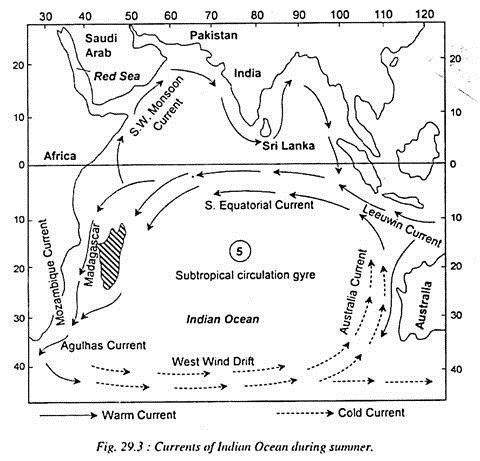ADVERTISEMENTS:
The following points highlight the six main currents in the Indian ocean. The currents are: 1. North-East Monsoon Current 2. Indian Counter Current 3. S.W. Monsoon Current 4. Indian Equatorial Current 5. Mozambiqe Current 6. West Wind Drift.
1. North-East Monsoon Current (Warm):
North-east monsoon winds blow from land to the ocean during winter season in the northern hemisphere and thus westward blowing north-east monsoon currents are produced between Andman and Somali (fig. 29.4). This current flows to the south of 5°N latitude. Besides, some independent currents originate in the Bay of Bengal and Arabian sea and flow in southwesterly direction.
2. Indian Counter Current (Warm):
Indian counter current is originated during winter season (northern hemisphere). This current flows in easterly direction between 2°-8°S latitudes from Zanzibar to Sumatra.
3. S.W. Monsoon Current (Warm):
ADVERTISEMENTS:
There is complete reversal in the direction of monsoon winds during summer season. In other words, north-easterly direction of winter monsoon winds becomes south-westerly during summer season in the northern hemisphere. This reversal of direction of monsoon winds also reverses the direction of ocean currents of Indian Ocean during summer season. Northeast monsoon ocean currents disappear and south-west monsoon ocean currents are developed.
The general direction of monsoon currents is from south-west to north-east (fig. 29.3) but several minor branches emerge from the main branch and move in the Bay of Bengal and Arabian Sea. The Indian counter current developed during winter season disappears due to this current.
4. Indian Equatorial Current (Warm):
The currents of the southern Indian Ocean are least affected by seasonal change in the direction of monsoon winds. The Indian equatorial current flows from east to west between 10°Sand 15°S latitudes from Australian coast to African coast. After being obstructed by Madagascar this current is divided into many branches. One major branch flows southward in the name of Agulhas current (warm) while the other branch is directed towards the north.
5. Mozambiqe Current (Warm):
One branch of the southern Indian equatorial current moves southward through Mozambiqe Channel known as Mozambiqe current. This current joins the Agulhas current near 30°S latitude and moves upto the southern tip of Africa and is ultimately diverted eastward.
6. West Wind Drift (Cold):
Like Pacific and Atlantic Oceans eastward flowing current, known as west wind drift, is also generated in the Indian Ocean. This current is produced due to eastward blowing westerlies along 40°N latitude known as ‘roaring forties’. This current bifurcates in two branches near 110°E longitude.
One branch turns northward and flows as West Australia cold current along the western coast of Australia and near the Tropic of Capricorn turns towards west and north-west and ultimately merges with the south equatorial current near 100°E longitude. The second branch of the west wind drift turns southward.

